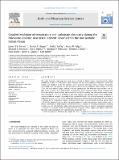Files in this item
Coupled evolution of temperature and carbonate chemistry during the Paleocene-Eocene; new trace element records from the low latitude Indian Ocean
Item metadata
| dc.contributor.author | Barnet, James S. K. | |
| dc.contributor.author | Harper, Dustin T. | |
| dc.contributor.author | LeVay, Leah J. | |
| dc.contributor.author | Edgar, Kirsty M. | |
| dc.contributor.author | Henehan, Michael J. | |
| dc.contributor.author | Babila, Tali L. | |
| dc.contributor.author | Ullmann, Clemens | |
| dc.contributor.author | Leng, Melanie J. | |
| dc.contributor.author | Kroon, Dick | |
| dc.contributor.author | Zachos, James C. | |
| dc.contributor.author | Littler, Kate | |
| dc.date.accessioned | 2020-07-29T14:30:07Z | |
| dc.date.available | 2020-07-29T14:30:07Z | |
| dc.date.issued | 2020-09-01 | |
| dc.identifier | 269365004 | |
| dc.identifier | f1e88af8-e40d-44b9-92ef-8e5a9386a528 | |
| dc.identifier | 000549183200013 | |
| dc.identifier | 85086580044 | |
| dc.identifier.citation | Barnet , J S K , Harper , D T , LeVay , L J , Edgar , K M , Henehan , M J , Babila , T L , Ullmann , C , Leng , M J , Kroon , D , Zachos , J C & Littler , K 2020 , ' Coupled evolution of temperature and carbonate chemistry during the Paleocene-Eocene; new trace element records from the low latitude Indian Ocean ' , Earth and Planetary Science Letters , vol. 545 , 116414 . https://doi.org/10.1016/j.epsl.2020.116414 | en |
| dc.identifier.issn | 0012-821X | |
| dc.identifier.other | ORCID: /0000-0003-3885-5664/work/78205135 | |
| dc.identifier.uri | https://hdl.handle.net/10023/20365 | |
| dc.description | This work was principally funded by a European Consortium for Ocean Research Drilling (ECORD) Research Grant, the International Association of Sedimentologists (IAS) Postgraduate Research Grant Scheme, and the Natural Environment Research Council (NERC) Isotope Geosciences Facility (IP-1581–1115), awarded to James Barnet and Kate Littler. LJL acknowledges funding from the IODP-JRSO (NSF grant 1326927), KME acknowledges funding from NERC grants NE/H016457/1 and NE/P013112/1, and CVU acknowledges funding via NERC grant NE/N018508/1. | en |
| dc.description.abstract | The early Paleogene represents the most recent interval in Earth's history characterized by global greenhouse warmth on multi-million year timescales, yet our understanding of long-term climate and carbon cycle evolution in the low latitudes, and in particular the Indian Ocean, remains very poorly constrained. Here we present the first long-term sub-eccentricity-resolution stable isotope (δ13C and δ18O) and trace element (Mg/Ca and B/Ca) records spanning the late Paleocene-early Eocene (similar to 58-53 Ma) across a surface-deep hydrographic reconstruction of the northern Indian Ocean, resolving late Paleocene 405-kyr paced cyclicity and a portion of the PETM recovery. Our new records reveal a long-term warming of similar to 4-5 °C at all depths in the water column, with absolute surface ocean temperatures and magnitudes of warming comparable to the low latitude Pacific. As a result of warming, we observe a long-term increase in δ18Osw of the mixed layer, implying an increase in net evaporation. We also observe a collapse in the temperature gradient between mixed layer- and thermocline-dwelling species from similar to 57-54 Ma, potentially due to either the development of a more homogeneous water column with a thicker mixed layer, or depth migration of the Morozovellain response to warming. Synchronous warming at both low and high latitudes, along with decreasing B/Ca ratios in planktic foraminifera indicating a decrease in ocean pH and/or increasing dissolved inorganic carbon, suggest that global climate was forced by rising atmospheric CO2 concentrations during this time. | |
| dc.format.extent | 15 | |
| dc.format.extent | 1133186 | |
| dc.language.iso | eng | |
| dc.relation.ispartof | Earth and Planetary Science Letters | en |
| dc.subject | Trace elements | en |
| dc.subject | Paleoclimate | en |
| dc.subject | Paleoceanography | en |
| dc.subject | Paleogene | en |
| dc.subject | Paleocene-Eocene Thermal Maximum | en |
| dc.subject | Indian Ocean | en |
| dc.subject | GE Environmental Sciences | en |
| dc.subject | NDAS | en |
| dc.subject | SDG 13 - Climate Action | en |
| dc.subject.lcc | GE | en |
| dc.title | Coupled evolution of temperature and carbonate chemistry during the Paleocene-Eocene; new trace element records from the low latitude Indian Ocean | en |
| dc.type | Journal article | en |
| dc.contributor.institution | University of St Andrews. School of Earth & Environmental Sciences | en |
| dc.identifier.doi | 10.1016/j.epsl.2020.116414 | |
| dc.description.status | Peer reviewed | en |
This item appears in the following Collection(s)
Items in the St Andrews Research Repository are protected by copyright, with all rights reserved, unless otherwise indicated.

